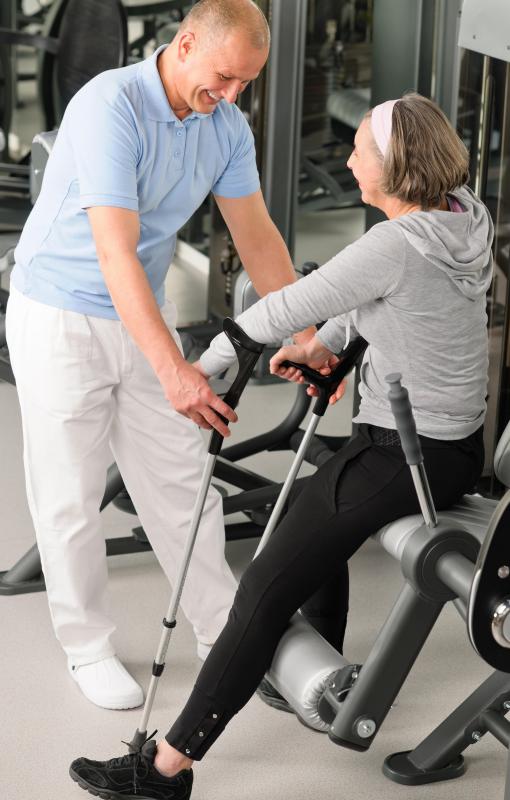At WiseGEEK, we're committed to delivering accurate, trustworthy information. Our expert-authored content is rigorously fact-checked and sourced from credible authorities. Discover how we uphold the highest standards in providing you with reliable knowledge.
What are the Best Tips for Walking with Crutches?
The first and most important tip for walking with crutches is to make sure to get the correct size crutches. Most crutches are adjustable, though it is still important to make sure they are adjusted to the proper height for the person using them. When walking with crutches for the first time, it is a good idea to have someone stand close by in case the user loses his or her balance, as walking with crutches can be difficult at first. He or she should attempt climbing stairs with the crutches during this practice period as well, as this can be one of the most challenging parts of using crutches.
Once the crutches are fitted properly to the user and he or she has had an opportunity to practice with them, it may be a good idea to take a break from walking with crutches. Using them too much can result in chafing in the armpits and sores or bruises on the palms of the hand. The cushioning on the crutches tends to wear out quickly, so some people choose to wrap extra fabric around the armpit and hand supports. The user should keep in mind, however, that soreness is likely no matter how much padding is used, which is why it is important to rest periodically when walking with crutches to prevent or alleviate soreness and pain associated with the process.

It is important to remember that walking with crutches takes up more room than walking without them, so the user is likely to have some difficulty getting through narrower spaces such as doorways. Keeping this in mind can help prevent bumps and bruises from collisions with doorways and other objects that may make a pathway or room narrow. Keeping one's weight on the hands rather than the armpits can increase dexterity of movement, and wearing a backpack can allow the user to place items in the pack and move them without the use of the hands, which will be occupied by the crutches.

Walking with crutches outdoors poses even more obstacles. In the winter, ice and snow can make the process of crutch use more difficult and quite dangerous. If the user suspects the ground is icy, he or she should take smaller steps with the crutches and double check to make sure the ends of the crutches are making solid contact with the ground. Dirt and sand can also lead to an unstable walking surface, so a crutch user should be aware of the conditions beneath him or her at all times.
AS FEATURED ON:
AS FEATURED ON:














Discussion Comments
I found walking on crutches to be exhausting at first, but then I started getting into a rhythm and making better time. I tried the forearm crutches at the medical supply store, but I personally felt more comfortable with regular wooden crutches. I think if I had to be on them for an extended period of time, I'd probably use the forearm crutches, but I felt like I wasn't getting the same rocking motion as I did with the regular type of crutches.
When I broke my ankle playing basketball, I had to learn how to walk on crutches. One thing I learned was the importance of adjusting everything that can be adjusted, not just the distance from the floor to your armpit. The handgrips also need to be adjusted, since that's where a lot of the weight will fall.
I also learned to let the crutches do their job. They aren't going to help you walk "normally". It's more of a pivot action, where you plant the crutches ahead of your body and allow your legs to swing through them. For a while, I was using one crutch on the opposite side of my body and hopping around. It wore me out, and didn't do much for my mobility. Use two crutches and take advantage of the pivot action.
Post your comments